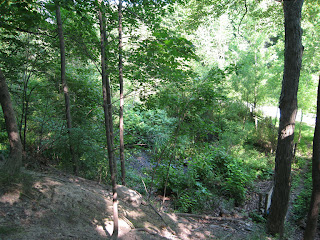I have been the stewardship team leader for the Nordheimer Ravine at Spadina and St. Clair for the past eight years since the two wetland sites were created in partnership by the city of Toronto’s department of Natural Environment in Parks, Forestry and Recreation, and the Task Force to Bring Back the Don. It is my pleasure each year to be a part of what occurs in the ravine and its constructed wetlands, aiding to assist the wild to become the everyday.
There are two restoration wetland sites used to soak up runoff, catch rain water and restore native wildlife species. The first, the Roycroft, has a shallow rain filled pond and is predominantly treed with aisles allowing for wildflowers and a raised berm along the walkway. It is considered a hardwood forest wetland.

Looking down on the east end of the Roycroft and the pond.
The second the Glen Edyth is a meadow wetland with a meadow in front, and a large horseshoe shaped pond at the back filled from a stream in the ravine slope. The pond is sheltered by trees and shrubs.
Castlefrank Brook originally flowed through the ravine but in the 1970s the brook was buried in the storm water system in preparation for the Spadina Expressway that never was constructed.

Looking down from the slope west of the Glen Edyth wetland at the pond.
The main tasks of the stewards in the ravine each summer is to weed out invasive and nonnative plant and monitor plants that are growing for variety and status as nonnative, native or invasive. Over the years the number of native species has increased without planting and now there is little weeding in the wetlands proper. However, the path between the two sites and the meadow in front of the Glen Edyth still require weeding. The most invasive plants taken out are Burdock, Purple Loosestrife, Queen Anne’s Lace, Canada Thistle, Bird’s Foot Trefoil, and Japanese Knotweed. There is also a new patch of Dog-strangling Vine further west in the ravine near a small Skunk Cabbage wetland. We also remove Ragweed to prevent allergic reactions.

Looking east at the Glen Edyth Wetland.
The sites and the ravine have become very plentiful in wild flowers, from Marsh Marigolds to asters of varying colors in the sites and outside, to Potato Vine, Michigan Lily, Turtlehead, Joe Pye-weed, and Vervain, and two varieties of rose amongst others. There are also ferns, and sedges, many cattails, arrowheads, and grasses.

Bee on Cone Flower in the meadow in the Glen Edyth.

Monarch butterfly on Joe Pye Weed in the Roycroft.
In the summer of 2006 a request for proposed development on one segment of the ravine slope across the ravine from the Glen Edyth was taken to the Ontario Municipal Board. The decision is still pending. This particular slope is unusually healthy, and according to a Toronto and Region Conservation Area expert it is close to being old growth forest. Since European settlement it has almost always been forest. It was necessary to express to the OMB the importance of what occurs there both as restorative and innate to people and wildlife and protected as designated in the city’s planning act and by-laws.

Slope west of the Roycroft wetland.

Plantain by the duck weed covered pond at the back of the Glen Edyth.
Many animals inhabit or visit the ravine. Squirrels, Red-tailed Hawks, multiple varieties of songbirds, butterflies, bees and slugs, a few foxes and raccoons, and a one time sighting of traveling deer. It is also popular place with daily visits by dogs and people. It is also a fairly safe area. Despite isolated incidents a few years back, it has become a good place to stroll and read the educational signs set out by the city.

Signs in front of the Glen Edyth wetland.
This posting and pictures are courtesy of Susan Aaron, stewardship leader at the Nordheimer Ravine wetlands. If you are interested in helping out in 2007, contact the city Summer volunteer program.
No comments:
Post a Comment